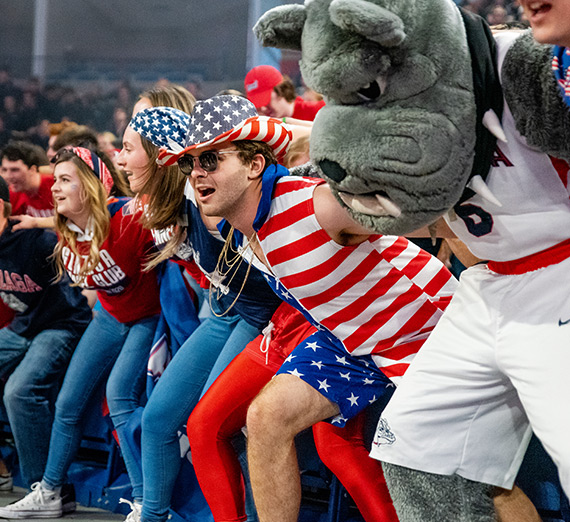“We Are G.U.” Chronicles Kennel Club Antics Since Its Origin in 1984

This piece originally appeared as the foreword to the book "We Are G.U. The Origins, History and Impact of Gonzaga University’s Kennel Club" by Mike Shields and Aaron Hill.
You know the old notion: if people on all sides think you're wrong, you're probably doing something right.
This isn't a universal truth, of course, but in case of the Kennel Club, it's pretty close.
Because when it comes to the KC, the darts come from all directions. Not that it's hate. Not at all. You can't be in the McCarthey Athletic Center on big game night – Pepperdine or Santa Clara in the old days, Saint Mary's or BYU or anyone in the Top 25 of late – and hate what the Kennel Club brings to the vibe. College basketball is meant to be played in an atmosphere of both visual and visceral delights, and sometimes they have to be manufactured outside the lines.
The players can do their part – an alley-oop dunk, a get-that-outta-here blocked shot, an unconscionably deep 3-pointer that finds nothing but net as the Bulldogs break open another game.
But the rush from any of those plays is enhanced by the reaction of the eyewitnesses – roars that bow the walls, the animated delirium, the chants that tell the opponents they're down by 30 and the team bus is idling outside. And let's not forget getting in the visitors' heads in the warmups before tipoff.
At Gonzaga, this specifically is the job of the Kennel Club, the undergraduate parcel of the nightly sellout crowd that fills McCarthey's lower north side.
They hoist the big-head portraits of the players, stomp and sway to Zombie Nation and clamor for the end-of-the-bench walk-ons to play when the game is out of hand.
And by pretty much consensus acclaim – from the Zags players, assorted basketball meteorologists in the media and, yes, the members themselves – the KC is among the best at this particular craft in the country.
Is this a big deal?
Don't even bring up the KC's role in Gonzaga's glitzy home record since the McCarthey opened in 2004 (192-15 – a cool 92.8 percent) – or that it was even better over the 12 years before that in the joint next door. Don't speculate how many times the KC's outsized presence clinched the deal on a recruit who made a visit on game night.
Just ask the opposing players and coaches who do their thing in home arenas that are half empty and often painfully indifferent.
So how did all of this begin and evolve?
That's right: it all got rolling back when Gonzaga basketball was just another game – those years when the KC itself never would have thought to make "Final Four" their flying-bodies spell-out during a timeout.
That's as much the phenomenon as the manic mob you see on ESPN game nights now.
It's a messy history, to be sure, and the authors acknowledge that the Kennel Club has never been everyone's cup of cheer.
Sedate fans across the gym thought the group unruly and coarse. The campus fathers blanched – at over-the-line language, over-imbibing at pre-funks and some overly entrepreneurial capitalism – and eventually brought group under school control.
Which has only birthed different criticisms today. That the KC lacks creativity and danger. That the cheers are stale and the signs are lame. That the students only show up in full force for three or four big games.
Like we said, darts from all directions. Well, not all. You know who never complains?
The players.
Anyway, the point of the Kennel Club was never perfection. It was mostly to take something fun – Gonzaga basketball – and make it more fun, and it seems as if the mission is still being accomplished.
Now take a walk through this history and see if it doesn't do the same thing.
